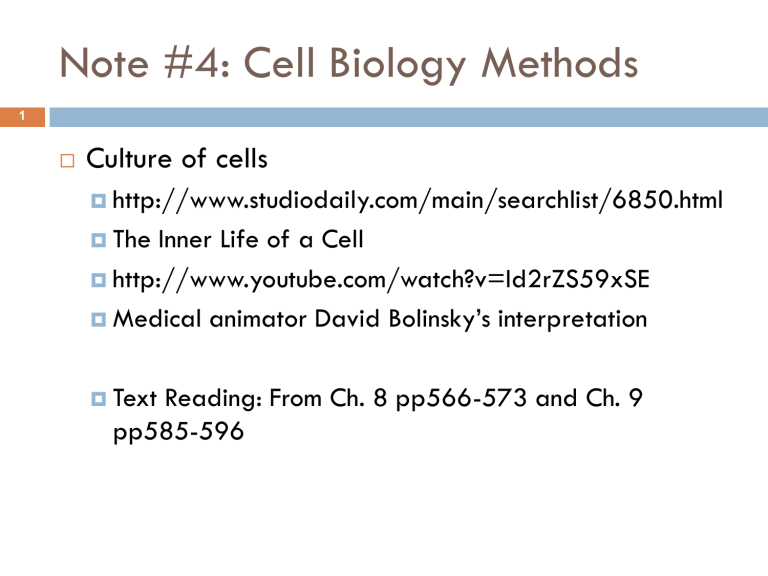
Note #4: Cell Biology Methods 1 Culture of cells http://www.studiodaily.com/main/searchlist/6850.html The Inner Life of a Cell http://www.youtube.com/watch?v=Id2rZS59xSE Medical animator David Bolinsky’s interpretation Text Reading: From Ch. 8 pp566-573 and Ch. 9 pp585-596 How to obtain cells to study 2 Tissue culture: A terminology for procedures used for maintenance and growth of cells or organs in an artificial and aseptic environment. Cell culture: Cells can be isolated from intact tissues and cultured as isolated cells Organ culture (explant cultures): The culture of the whole or fragments of an organ to study the development. Started early 1900; an explant of spinal cord tissue Late 1940’s and early 1950’s, tissue culture became easier to do by: 1. 2. 3. The use of antibiotics to control contamination; Development of chemically defined, nutrient-rich media to grow cell lines; The use of trypsin (protease) and collagenase to remove cells from the tissue and the plastic vessel. Culture of primary cells 3 Removal of tissue or organs from animals and plants, and growing in artificial, aseptic environment. Cut and mince with scissors Dissociate the tissue with trypsin and collagenase enzymes to prepare cell suspension. Artificial environment can be glass or polystyrene plastic vessels containing liquid or semi-solid medium that supplies nutrient. Adhering Cells can be grown on plastic, usually grown in humid environment, in atmosphere of 510% CO2 pH 7.2-7.5 Some cells require attachment factors - plastic can be coated with gelatin, collagen, fibronectin, laminen (extracellular matrix). Cell Properties Many of the cell properties are maintained in culture, including cell shape, indicative of the cell origin, and function. Figure 8-4 Molecular Biology of the Cell (© Garland Science 2008) Primary Cells 5 Primary cells have a finite lifespan. Replicative cell senescence: process by which primary cells slow proliferation and then eventually die (95%). “Immortalized” Cell line can grow continuously. Cells can be immortalized by introducing oncogenes or telomerase gene. 6 Normal cells are anchorage dependent and contact inhibited 7 Monolayer Reach confluency after a certain time. The surface of the plate is covered with one layer of cells (monolayer) Transformed cell lines (cancer cells) are anchorage-independent; not contact inhibited Exception: Blood cells (lymphoblast cells), which are normal cells, do not normally attach to substrates and always grow in suspension. Multilayer Spinner bottles Summary 8 Primary Cells From living organism - normal cells Have to isolate from living organism. Have a finite lifespan. Undergo replicative cell senescence. Normal cells Contact inhibited Grow as mono-layer on a plastic dish Reach confluence Anchorage-dependent Cell lines Easier to obtain (access) “Immortalized” cell line can grow continuously. Cell line can have abnormal chromosome number. Transformed cells Not contact inhibited Can grow as multi-layer on a plastic dish. Form foci Achorage-independent - can grow in suspension or in soft agar Monoclonal antibody production in hybridoma Figure 8-8 (part 1 of 2) Molecular Biology of the Cell (© Garland Science 2008) Figure 8-8 (part 2of 2) Molecular Biology of the Cell (© Garland Science 2008) Stem cells: 11 Multiopotent: can differentiate into several other cell types. Typical of adult stem cells. Pluripotent: can differentiate into all other cell types. Typical of embryonic stem cells. Embryonic stem cells Embryonic Stem Cells 12 Embryonic stem cells (ES) harvested from the inner mass of the early embryo can proliferate indefinitely; have ability to give rise to different differentiated cells after treatment with retinoic acid, hormones, growth factors, etc. Pluripotent Figure 23-68 Molecular Biology of the Cell (© Garland Science 2008) Cell Isolation and Cell sorting 13 1. Prepare cell suspension by enzymatic digestion 2. Treat tissue with Trypsin, Collagenase Cell Sorting by cell size: Gravity sedimentation through a density gradient by Fluorescence activated cell sorter by Magnetic beads 3. 4. Laser Capture Microdissection Use an unusual characteristic of specific cells Preferential adherence to the surface of culture dishes Sensitivity to pH Cell Sorting by cell size: Gravity Sedimentation 14 Using Magnetic beads 15 Cell sorting by Fluorescence Activated Cell Sorter 16 Cell surface protein is marked by fluorescence. Fluorescent cells are sorted from nonfluorescent cells DNA can be marked by fluorescence. 2N, N, 4N cells are sorted by the amount of fluorescence. Laser Capture Microdissection 17 Differential Adhesion 18 Barkhatov I.M.1, Roumiantsev S.A.2, Vladimirskaya E.B.2, Afanasyev B.V.1 “Composition and functional properties of monolayer cell culture from human umbilical cord blood “ Cellular Therapy and Transplantation (CTT), Vol. 1, No. 2, 26 December 2008



